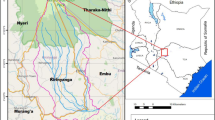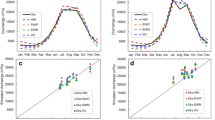Abstract
Short-term streamflow forecasting is a widely used and important aspect of modern water management. In contrast, routine operational forecasting of stream water quality remains relatively limited. Turbidity is a commonly-monitored, key water-quality parameter. It can often be used to estimate other water-quality parameters and can serve as an overall indicator of stream environmental health. In this study, short-term (3-day) turbidity forecasts during streamflow events for two Mid-Atlantic U.S. streams were produced using a combination of forecast discharge, precipitation and air temperature, together with observations leading up to the issue time of the forecast. The turbidity forecast error was found to be relatively constant with lead time and significantly less than the persistence reference error for nearly all lead times. The turbidity forecast uncertainty due to streamflow forecast uncertainty was also evaluated. Potential future improvements for the example turbidity forecasts presented here are discussed. This study demonstrates for the first time that currently-available inputs (i.e., forecast discharge, precipitation and air temperature) can yield useful stream turbidity forecasts.






Similar content being viewed by others
References
Anderson C (2005) Turbidity (ver. 2.1): U.S. Geological Survey Techniques of Water-Resources Investigations, Book 9, Chapter A6. Section 6(7)
Brady AMG, Bushon RN, Plona MB (2009) Predicting Recreational Water Quality Using Turbidity in the Cuyahoga River, Cuyahoga Valley National Park, Ohio, 2004–7. U.S. Geological Survey Scientific Investigations Report:2009–5192
Christensen VG (2001) Characterization of surface-water quality based on real-time monitoring and regression analysis, Quivira National Wildlife Refuge, South-Central Kansas, December 1998 through June 2001. U.S. Geological Survey Water-Resources Investigations Report 01-4248
Crockett Consulting (2010), City of Wilmington Source Water Protection Plan, Available from: http://www.ci.wilmington.de.us/government/sourcewater (Accessed 1 February 2015)
Dearmont D, McCarl B, Tolman D (1998) Costs of water treatment due to diminished water quality: a case study in Texas. Water Resour. Res. 34(4):849–854. doi:10.1029/98WR00213
Duncan S, Grant G (2003) Clarifying muddy water: Probing the linkages to municipal water quality. U.S. Department of Agriculture, Forest Service, Pacific Northwest Research Station, Portland, OR
Falcone, J. A. (2011), GAGES-II: Geospatial Attributes of Gages for Evaluating Streamflow (Digital Dataset), U.S. Geological Survey.
Francy DS, Darner RA, Bertke EE (2006) Models for Predicting Recreational Water Quality at Lake Erie Beaches. U.S. Geological Survey Scientific Investigations Report 2006-5192
Helsel, D., and R. Hirsch (2002), Statistical methods in water resources, Techniques of Water-Resource Investigations of the U.S. Geological Survey: Book 4, Hydrologic Analysis and Interpretation, Chapter A3, pp. 305–306. Available from: http://water.usgs.gov/pubs/twri/twri4a3/.
Iglesias C, Martínez Torres J, García Nieto PJ, Alonso Fernández JR, Díaz Muñiz C, Piñeiro JI, Taboada J (2014) Turbidity Prediction in a River Basin by Using Artificial Neural Networks: A Case Study in Northern Spain. Water Resour. Manag. 28(2):319–331. doi:10.1007/s11269-013-0487-9
Mather AL, Johnson RL (2014) Quantitative characterization of stream turbidity-discharge behavior using event loop shape modeling and power law parameter decorrelation. Water Resour. Res. 50(10):7766–7779. doi:10.1002/2014WR015417
Mather AL, Johnson RL (2015) Event-based prediction of stream turbidity using a combined cluster analysis and classification tree approach. J. Hydrol. 530:751–761. doi:10.1016/j.jhydrol.2015.10.032
New Jersey Water Supply Authority (2002), Raritan Basin Portrait of a Watershed, Available from: http://www.raritanbasin.org/alliance/documents/summary_report.pdf (Accessed 1 February 2015)
NOAA (2014a), Top Ten Highest Historical Crests: Brandywine Creek at Wilmington, Available from: http://www.erh.noaa.gov/marfc/Rivers/FloodClimo/Top_Flood_Crests/Sch/Wilmington-SEPA-Top10-Table.pdf (Accessed 1 February 2015)
NOAA (2014b), Top Ten Highest Historical Crests: Raritan River at Manville, Available from: http://www.erh.noaa.gov/marfc/Rivers/FloodClimo/Top_Flood_Crests/Rtn/Manville-RTN-Top10-Table.pdf (Accessed 1 February 2015)
Portland Water Bureau (2011), Discover your drinking water, Available from: http://www.portlandoregon.gov/water/article/225481 (Accessed 1 February 2015)
Seeger M, Errea M-P, Beguerı́a S, Arnáez J, Martı́ C, Garcı́a-Ruiz JM (2004) Catchment soil moisture and rainfall characteristics as determinant factors for discharge/suspended sediment hysteretic loops in a small headwater catchment in the Spanish pyrenees. J. Hydrol. 288(3-4):299–311. doi:10.1016/j.jhydrol.2003.10.012
Shamir E, Carpenter TM, Fickenscher P, Georgakakos KP (2006) Evaluation of the National Weather Service Operational Hydrologic Model and Forecasts for the American River Basin. J. Hydrol. Eng. doi:10.1061/(ASCE)1084-0699(2006)11:5(392
Towler E, Rajagopalan B, Summers RS, Yates D (2010) An approach for probabilistic forecasting of seasonal turbidity threshold exceedance, Water Resour. Res. 46(6):–W06511. doi:10.1029/2009WR007834
U.S. EPA (1999), Guidance Manual for Compliance with the Interim Enhanced Surface Water Treatment Rule: Turbidity Provisions: U.S. Environmental Protection Agency, EPA 815-R-99-010.
Welles E, Sorooshian S, Carter G, Olsen B (2007) Hydrologic verification: A call for action and collaboration. Bull. Am. Meteorol. Soc. 88:503–511. doi:10.1175/BAMS-88-4-503
Yang T-M, Fan S-K, Fan C, Hsu N-S (2014) Establishment of turbidity forecasting model and early-warning system for source water turbidity management using back-propagation artificial neural network algorithm and probability analysis.,. Environ. Monit. Assess. 186(8):4925–4934. doi:10.1007/s10661-014-3748-z
Acknowledgments
This study was financially supported by Oregon Health & Science University. This research was possible due to the availability of observational data through the U.S. Geological Survey (USGS) and archived forecasts through the National Oceanic and Atmospheric Administration (NOAA) National Weather Service (NWS).
Author information
Authors and Affiliations
Corresponding author
Electronic supplementary material
ESM 1 Supporting Information
(PDF 2863 kb)
Rights and permissions
About this article
Cite this article
Mather, A.L., Johnson, R.L. Forecasting Turbidity during Streamflow Events for Two Mid-Atlantic U.S. Streams. Water Resour Manage 30, 4899–4912 (2016). https://doi.org/10.1007/s11269-016-1460-1
Received:
Accepted:
Published:
Issue Date:
DOI: https://doi.org/10.1007/s11269-016-1460-1




